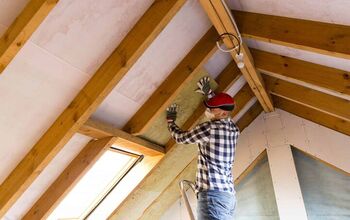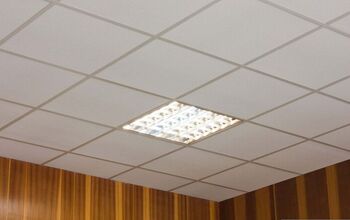How To Add Insulation To A Vaulted Ceiling (Step-by-Step Guide)

Adding insulation can be a task depending on the size of your rooms or attics. Try applying the same logic to a vaulted ceiling, and you’ve got the potential of having a pretty big headache. Because of this, we’ve produced a short guide to help you out with insulation in vaulted ceilings.
First, you will need to measure the distance between your rafters. Take that distance and count the number of rafters above, multiplying the two numbers. For roll insulation and foam board insulation, you will need to cut based on the initial measurements you took. Scrap from the projects can be placed around recessed lights as required.
Below, we are going to be getting into the details behind this process. We will also get into how this changes with different types of insulation.
Do You Need Insulation Installers?
Get free, zero-commitment quotes from pro contractors near you.

Adding Insulation to Your Vaulted Ceiling: A Step-by-Step Process
- Be sure you have the right equipment available
- Check and remove any lousy insulation.
- Use the pre-existing insulation to determine the necessary height and width you need.
- Buy insulation based on The R-Value For Your Location
- Cut and install the insulation
Below, we will be digging into the details of these steps.
Have the Right Equipment Available
Below is a list of items you need to add or replace insulation
- Protective gear for eyes, head, and ample skin covering
- Utility knife
- Insulation meeting the right R-value for your zone
- Measuring tape
- Thick plastic bags
- Ladder
- Nails
- Nail gun or hammer
Ensure that you have ample protection for your insulation project. Insulation touching your skin can irritate.
Step One: Check and Remove Bad Insulation
The first step to adding insulation to your vaulted ceiling is a check. Any damaged, flat, or disgusting insulation will need out. It is especially important when it comes to finding insulation with mold or mildew.
With a combination of a utility knife, a ladder, and some plastic bags, this should be relatively simple. Cut out the bad sections and throw them into a plastic bag. Given that these are bad sections, you will not be able to donate or recycle them.
You will also want to take the opportunity to remove a section of insulation for your next step.
Step Two: Measure the Height, Width, and Depth of the Rafters
The good chunk of insulation you tore out will give you a good idea of the height and width you need. Depending on the depth of your ceiling, this will avoid you having to make any awkward maneuvers on your ladder. Measure the insulation, not the rafters.
Using a clean piece of rafter from what you pulled out, you can also take the opportunity to measure for depth. This information will be necessary, as you will need it to determine the quality of insulation that you need based on your R-Value.
If the previous insulation isn’t snug, you will want to try and use a measurement from the rafters. You may need a set of two people and ladders to ensure a reliable measure.
We will be getting into what an R-Value is in just a moment. For now, focus on writing these figures down in a trusted space. You will need to bring them to a hardware store for the next step.
Step Three: Buy Insulation Based on the R-Value of Your State
The Energy Star Website gives you a list of R-Values based on a combination of your state and where the insulation is. For example, you wouldn’t put the insulation you typically put on your floor in your attic; that would be a waste of money.
When shopping around at a hardware store, look for the r-ratings of the insulation you want. If you are keeping the old insulation, be sure to take the R-value of that insulation into account.
If you aren’t sure what the R-value of that insulation is, it may be best for you to start from the beginning. However, you can typically find that insulation from the old homeowner or branding on the insulation itself.
You are going to want to shoot for something near R30, as this is the insulation level for attics, which are on the same level as vaulted ceilings. Combine that with information related to the depth of your rafters, and you will know what to purchase.
Step Four: Cut and Install The Insulation
Cut the insulation to the measurements labeled earlier. The insulation should be snug, which you have already considered, given that you used pre-existing insulation for measurements.
If you used the rafters to take these measurements, you might need to run a test where you slightly reduce the height and width until you find the right size. Always start with an overestimation. It’s easier to remove insulation than add insulation.
If you need to add nails or staples, try and limit this. There are some cases where friction will not be enough to hold this insulation.
Do You Need Insulation Installers?
Get free, zero-commitment quotes from pro contractors near you.

Related Questions
Can I Use Spray Foam Insulation For Vaulted Ceilings?
While it may seem like anything you spray into a vaulted ceiling may fall out, there are cases where spray foam insulation has success. The key is to spread it in such a way where you avoid condensation.However, there have also been reports of people dealing with rot down the road. The problem with standard rolls is that they can slip, causing your insulation to start leaking.
What is the Difference Between Vaulted Ceilings and Cathedral Ceilings?
Vaulted ceilings have two straight sides that meet together at a point. They also do not follow the pitch of the roof.Cathedral ceilings are beneath the roof and are known to be curved. Both still use the same general strategies for insulation. People will often use them interchangeably.
How Do I Handle Recessed Lighting In A Vaulted Ceiling While Insulating?
Many vaulted ceilings have recessed lighting. Before beginning your insulation project, there is a chance that you will need to work around them. Turn off the power before starting your job, and you will avoid an electric shock.While we mentioned scrap pieces, you don’t have to worry about scrap when using spray foam. Be sure that you fill in all gaps to avoid leaking insulation.
What Is The Cheapest Way To Insulate A Vaulted Ceiling?
Fiberglass batts are the most inexpensive in the short run. For the hotter zones, they are also pretty useful. Higher R-values in colder zones result in cheaper heating costs in the long run.Always consider the R-value when it comes to the level of expenses you are willing to tolerate.
Can I Use Rigid Foam To Insulate A Vaulted Ceiling?
In many vaulted ceiling insulation jobs, rigid foam is a stopping wall in conjunction with foam insulation. Placing drywall over this is a great and simple way for you to create a finished look.
Can You Use Fiberglass Insulation On An Unvented Vaulted Roof?
Yes. Just remember that it is essential to pay attention to the R-Value. Fiberglass insulation does tend to kick up a lot of dust. If you plan on replacing it, be sure to ventilate as much as possible while removing fiberglass batts.

I'm a guy who becomes the expert of whatever I stumble upon, writing-wise. I've written tons about cool home products, home improvement, and smart technology in the home. I'm also the proud father of a kiddo born on new years, making my holidays very busy.
More by Eli Smith



























